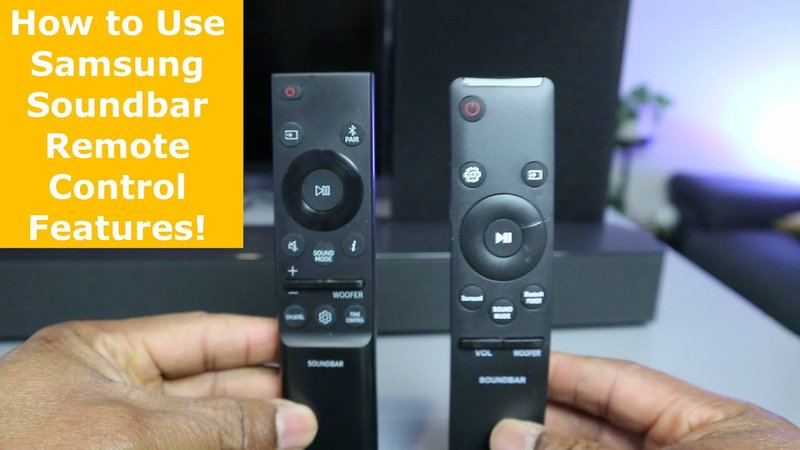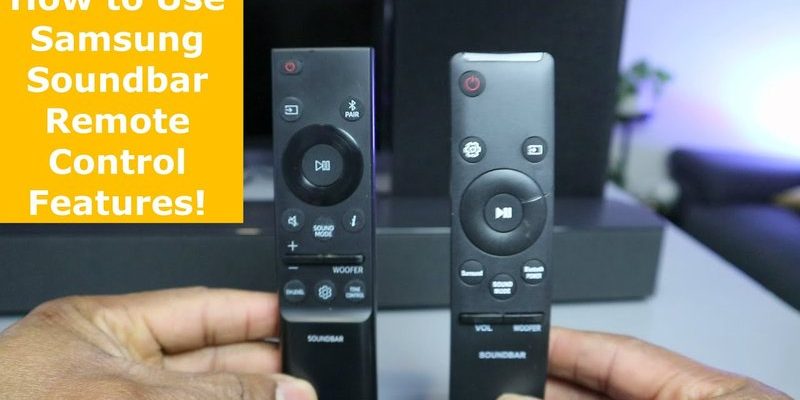
Now, you might be picturing your soundbar remote as that humble tool for adjusting the volume and, if you’re lucky, switching sound modes. But Samsung has quietly given some of their remotes superhero powers. With a little code-cracking and some patience, you can actually use your Samsung soundbar remote to control several devices at once. It might sound high-tech, but honestly, it’s not as complicated as assembling IKEA furniture (thank goodness). Let me explain step by step—no tech jargon, just real talk—so you can finally conquer that remote pile and control multiple devices from the comfort of your couch.
The Magic Inside Samsung Soundbar Remotes
Let’s start with what you’re actually holding in your hand. Samsung soundbar remotes come in a few varieties—some are the basic, no-fuss kind, and others have a few extra buttons for controlling different functions or devices. If you have one of the more recent soundbars, your remote might be branded as a “Samsung One Remote” or “Universal Remote.” Don’t worry, even if you’re not sure which one you have, most of what I’ll walk you through will work for both types.
These remotes use infrared (IR) signals, which is just a fancy way of saying they send invisible beams of light to “talk” to your devices. The trick is, your remote already has a secret stash of *codes* for TVs, streaming devices, and even DVD players. Kind of like a cheat sheet for each brand and model. When you pair it right, you can turn the TV on, adjust the volume, or even switch HDMI inputs—all from your soundbar remote. No wizard hat required.
Here’s the best part: you probably don’t need any special equipment or cables, and you won’t have to do any risky code hacking. All you need is a working Samsung soundbar remote and a little patience to pair everything up.
Pairing Your Remote: The Basic Setup
Alright, let’s get practical. If you want to control multiple devices with your Samsung soundbar remote, you’ll have to pair or sync it with each device. It’s a bit like teaching the remote a new language for each brand—tricky at first, but once you get the steps down, it’s smooth sailing.
First, make sure your remote has fresh batteries. I know—it seems obvious, but dying batteries are honestly the
Here’s a typical step-by-step process:
- Hold down the “Source” or “Mode” button on your remote until it lights up (usually a few seconds).
- Enter the code for your device. If your TV is a Samsung, it’s often a simple three-digit code, but it varies for other brands.
- The light should blink or stay on to confirm. Test by pressing the power or volume button to see if your device responds.
If it doesn’t work, try the next code on the list—sometimes it’s a little trial and error, but don’t lose hope! Pairing might sound old-school, but it’s actually how most universal remotes work under the hood.
Syncing With Multiple Devices: What Works And What Doesn’t
You might be wondering, “Can I really use just one Samsung soundbar remote to control everything?” To a degree, yes, but let’s set expectations. Most Samsung soundbar remotes are designed to control your soundbar and a TV. Some models can reach farther—to Blu-ray players or streaming boxes—but the range depends on your remote type and how new your soundbar is.
For example, if you have a Samsung TV and a Samsung soundbar, the handshake between the devices is usually seamless thanks to a tech called *Anynet+ (HDMI-CEC)*. This basically means the TV and soundbar can talk to each other through the HDMI cable, and your remote automatically works for both.
But if you’re trying to add a non-Samsung device, you’ll need to use the remote’s code learning or pairing mode. Soundbars with “Universal Remote” capability can sometimes sync with third-party devices, but the control is usually limited—think basic stuff like power, volume, or input switching. You probably won’t get deep functions like menu navigation or smart app control for every device.
So, in plain speak: the Samsung soundbar remote is awesome for consolidating basic controls, but don’t toss every other remote just yet. Think of it as your living room’s “volume and power MVP.”
Troubleshooting Common Problems
Let’s get real—sometimes, stuff just doesn’t work. Maybe your code isn’t accepted, a device isn’t responding, or your remote suddenly stops controlling the soundbar or TV. Before you panic-buy a universal remote, try these tried-and-true tips:
If your Samsung soundbar remote isn’t pairing, double-check the batteries. Weak batteries are sneaky troublemakers.
If you recently *reset* your soundbar or remote (like after a power surge), you might need to re-pair them. To reset, take the batteries out, wait 30 seconds, and pop them back in. Sometimes, holding down the “Power” or “Play/Pause” button for 10 seconds does the trick to refresh the remote’s brain.
If a device just won’t sync, it could be an issue with *line-of-sight*—all IR remotes need a clear path, so anything blocking the sensors will mess things up. Also, double-check that you’re using the right device code. Manufacturers change codes every so often, so new TVs or boxes might need updated codes from Samsung’s online database.
Lastly, if you’re still stuck, try a “universal code scan” if your remote supports it. This basically cycles through all possible codes—slow, but it’s often a last-resort lifesaver.
Differences Between Samsung Remote Types
You might have noticed there are a few different Samsung remote models rolling around—standard, “One Remote,” and even some with extra features like voice control. So how do you know which one you’ve got, or if it can handle multiple devices?
A classic Samsung soundbar remote usually just has buttons for volume, source, and sound mode. The “Samsung One Remote,” however, is a bit flashier and designed to control multiple devices, including TVs, soundbars, and streaming devices. If your remote has a microphone button or a “123” key, you’re probably holding a newer model.
In my experience, the One Remote is way easier for pairing—no weird button combos, just an on-screen setup that walks you through syncing devices. But with the older remotes, you’ll be relying more on manually entering codes and some trial and error.
Here’s a tip: if you’re shopping for a new soundbar or remote, look for one that mentions “universal” or “multi-device” control in the product description. It’ll make your life SO much easier.
Alternative Methods: Universal Remotes Versus Brand Remotes
Maybe you’re the type who likes options—so let’s talk about alternatives. Universal remotes from brands like Logitech, GE, or RCA can control pretty much anything under your roof, from window blinds to the popcorn machine (okay, maybe not that far). They’re great if you want one remote for absolutely everything, especially if your setup includes old DVD players or game consoles that the Samsung remote can’t handle.
Brand-specific remotes (like Samsung’s) have the edge in integration, especially with recent Samsung TVs and soundbars. Features like HDMI-CEC make everything talk to each other automatically, cutting out 90% of the setup headache. But for true control freaks or “techies,” a universal remote might still make sense, especially if you crave custom button layouts or macros (those magical single-press combos).
Honestly, it comes down to personal taste—ease and simplicity versus total customization. No wrong answer; just what fits your remote-wrangling style.
Keeping Your Remote In Top Shape
Here’s something people don’t talk about enough: taking care of your remote. It sounds silly, but remotes are like cars—they need a little TLC to keep running smoothly.
Keep your Samsung soundbar remote clean by wiping it down occasionally (just a damp cloth, no crazy chemicals). Dust in the buttons can make them stick or stop working. And always use good, fresh batteries—cheap ones leak, and that mess will ruin the contacts inside.
If you notice laggy responses or the need to press buttons extra hard, it might be time to clean or reset your remote. Some folks even use compressed air to clear out gunk from under the buttons. And if all else fails, replacements are easy to order online—just make sure you get the exact model for your soundbar.
It’s a little thing that makes a huge difference. I once lost a weekend to a sticky remote. Never again!
Why Consolidating Remotes Actually Matters
At first glance, learning to use one remote for multiple devices feels like a nerdy side quest. But if you’ve ever fumbled for the right remote in the dark—or had to explain the TV setup to an annoyed family member—you know why it matters. Life is just easier with fewer buttons to worry about.
Plus, there’s a nice side benefit: less clutter and fewer batteries to buy. The sense of control (pun intended) is real. You can actually sit back, relax, and watch a show without the dreaded “where’s the remote?!” panic.
And, hey, if a friend or family member comes over, you’ll look like an absolute pro handling everything with a single Samsung soundbar remote. Not a bad party trick.
Final Thoughts
So, can you control multiple devices with a Samsung soundbar remote? Absolutely—within reason. It’s a simple but powerful way to streamline your setup, reduce clutter, and make life a little more comfortable. As long as you’re patient with the pairing process, keep those batteries fresh, and don’t expect miracles (your soundbar remote isn’t a magic wand—yet), you’ll love the freedom it brings.
If you ever get stuck or need new codes, Samsung’s support pages are a goldmine. Or just ask someone who’s been through it—I promise you’re not alone in remote-wrangling land. Here’s hoping your next movie night is all popcorn, no technology headaches. Happy channel surfing!
